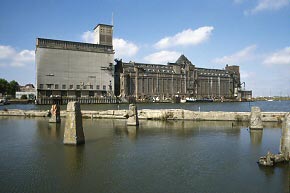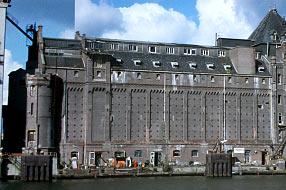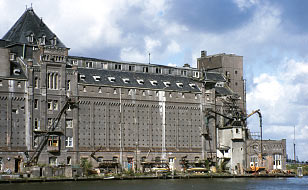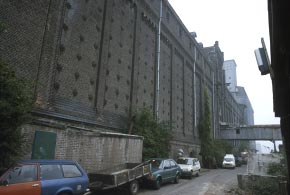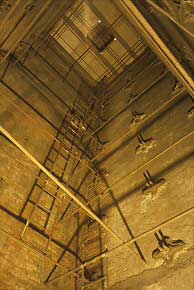BOOK:
DAVID CARR-SMITH - IMPROVISED
ARCHITECTURE IN AMSTERDAM INDUSTRIAL SQUATS & COLLECTIVES
"GRAIN-SILO"
SQUAT 1989 to 1998
SILO - INTRO
>
SILO - GROUND-FLOOR >
>
SILO - CENTRAL STAIR >
>
SILO - ATTICS >
>
SILO - DRYING TOWERS >
>
SILO - "CORNER TOWER" >
>
THE PUBLIC SILO & THE KROEG >
>
NEW-SILO - PUBLIC & PRIVATE >
|
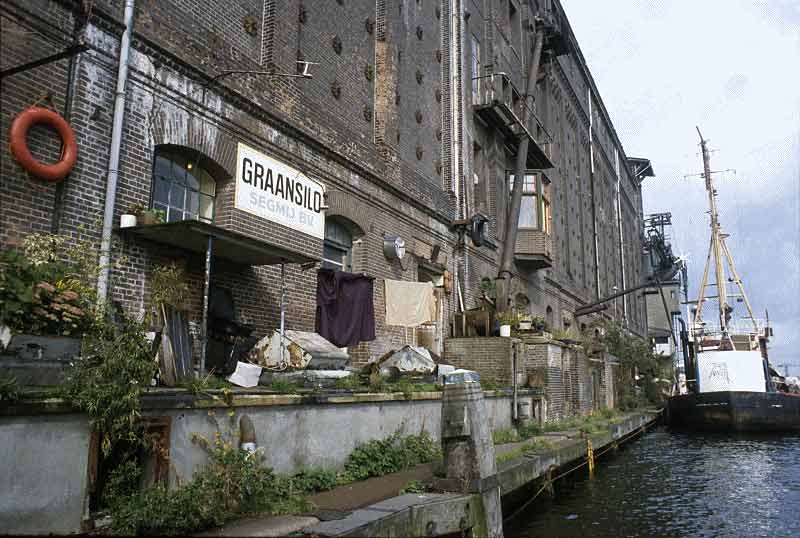
|
|
|
SILO
- E FACADE - QUAY WITH "PAPILLON" BOAT
(pic 9-94 / to NW)
The
Silo's narrow Quay path serves as an exterior route connecting to all the Silo's
internal private circulations. Some of the Ground-Floor apts open onto
it.
|
|
.
SILO
INTRODUCTION
THE
SITE
THE
SQUATTING
THE
FORM OF THE BUILDING
THE
SHAPE OF THE OCCUPATION
THE
DOMESTIC DOMAINS
AN
ENVIRONMENT OF PSYCHO-PHYSICAL AFFECTS
.
THE SITE
The "Graan-Silo"
(or rather ‘Silos’: two joined buildings for cleaning, drying, storing, and
pumping grain to and from ships and wagons) is one of the most noticeable
features of Amsterdam. It marks like a great gate-castle the western entry of
the wide sweep of Het Ij water across the northern boundary of the inner city.
Standing on some high projection
of the buildings one can watch all the complex traffic of the great
water-highway perform on the huge water-stage before the city and the Central
Station. Sometimes a white
cruise-ship, shockingly scaled to the city’s size, emerges round the far wing
of the bend and slowly takes possession of the enormous space scattered with
determined little boats.
The extreme north-western end of
Westerdoksdijk arrows out as a thin promontory dividing the barge-berths of the
Houthavens from the Ij - flanked at its landward end by the two silos, built out
into the water as if moored to its edge. Past the cubic concrete mass of the
1950’s “New Silo” the entry-road narrows onto the dijk through the steel
gate of the 1896 “Old Silo” - running as a straight forecourt of cobbles and
steel rails for 100 metres beneath its looming brick cliff, then continuing as a
long grass-embanked path out into the Ij, its tip saluting the ship-ways with a
yellow coded sign.
The “Silo” is the most
fabulous of a new wave (late 1980s 1990s) of large-scale squats. Motivated less by politics or a need for work-spaces than the powerful
childhood promise of forming ones own home in a locked castle away from the gaze
of the alter-ego of mass mores and taste; in a place of marvels that inspires
and provides means for invention…actualising dreams, not as art installations,
but to an extent that is tested by living in them.
.
the SITE AND APPROACH TO ENTRY
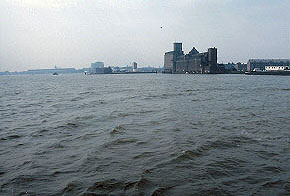
|
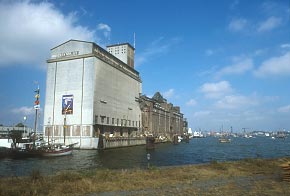
|
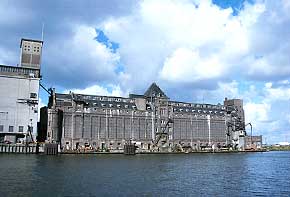
|
|
SILO FROM NORTH BANK OF THE IJ (DISTELWEG FERRY PORT)
(pic
6-94 / to SW)
|
SOUTH END FROM THE STENENHOOFD
(pic
8-95 / to NNW)
|
EAST
FACADE FROM THE STENENHOOFD
(pic
8-95 / to W)
|
|
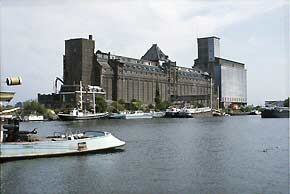
|
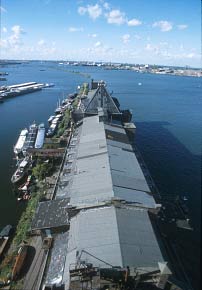
|
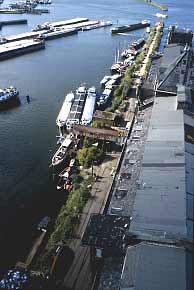
|
|
WEST FACADE FROM THE HOUTHAVENS
(pic
8-95 / to EES)
|
THE
SILO & ITS DIJK FROM THE NEW-SILO'S TOWER: [L7] JAROEN'S APT
(pic
9-94 / to N)
Westerdoksdijk, with its attached
Graan-Silo, juts out between the Houthavens and the Ij.
From
here we see the S-half of this symmetrical building. In its centre is the
"Pyramid", the Silo's 'head-house' and loft of the
"Museum", for grain distribution to the silos via the long
Attics. Much of these huge shallow and leaking Attic roofs were re-covered by
the Collective between 19##
and ##.
|
THE
SILO'S DIJK FROM THE NEW-SILO'S TOWER ROOF [L8]
(pic
9-94 / to NNW)
|
|
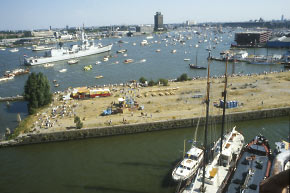
|
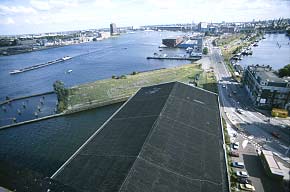
|
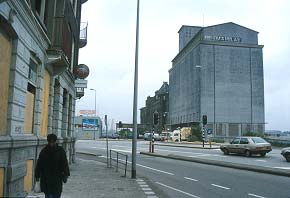
|
|
THE IJ ON "SAIL" DAY FROM
THE NEW-SILO
(pic
8-95 / to SSE)
"Sail"
day - viewed from the New-Silo L5 charging floor's
exterior walkway.
|
A VIEW FROM THE NEW-SILO'S TOWER ROOF [L8]
TOWARDS THE CITY
(pic
9-94 / to SSE)
The
view from the the New Silo's highest level - over its attic roof and along Westerdoksdijk towards the city
center, includes: [top-lft] Het
Ij water; [top-rt] Westerdok fringed by the long squatted shed De Loods with its quay
and dock; [bot-rt] entry to the Silos' dijk;
[mid-lft] the Stenenhoofd: an incomplete and abandoned
jetty.
|
THE
SILOS FROM THE STREET
(pic
6-94 / to N)
The
Silos viewed from Westerdoksdijk - just before it transforms from street to
industrial peninsula.
|
|
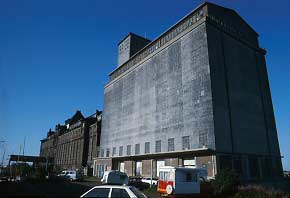
|
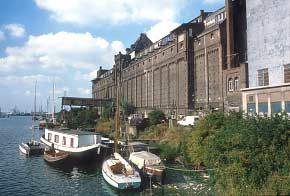
|
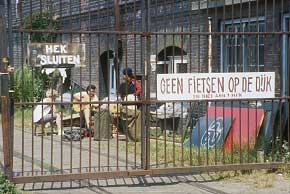
|
|
THE
ROAD ENTRY TO THE SILOS' PORTION OF THE DIJK
(pic
8-10-93 / to NNE)
Entry
to the Silos' portion of Westerdoksdijk - first past the 1950's 'New-Silo',
then through the gate of the 1896 Silo, and on to the end of the narrow
peninsula..
|
WEST FACADE
FROM THE HOUTHAVENS' SOUTH-EAST CORNER
(pic
8-95 / to N)
Only
from the Houthavens can the huge length of the old Silo be appreciated
|
ENTRY GATE ONTO THE OLD
SILO'S DIJK
(pic
6-94 / to NNE)
The
broad cobbled surface of the railwayed dijk fronts the cliff-like brick
facade of the old Silo.
|
.
the DIJK
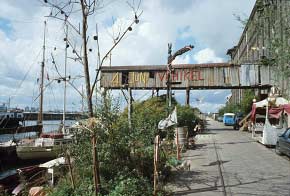
|
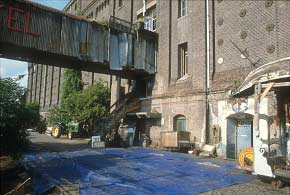
|
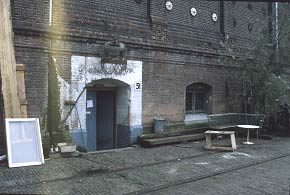
|
|
THE DIJK FROM NEAR THE OLD
SILO'S ENTRY GATE
(pic
9-94 / to N)
The
Dijk narrows into the distance flanked by inventions both frivilous and practical: a metal tree with mirror leaves, a flag, brazier, enormous wooden
totem, a mobile 'tram', an improvised stair, a chicken hutch, a customised
camper-van, Huub's lamps, little sitting places, the entry to the Kroeg
cafe.
|
THE DIJK FACADE NEAR THE
SILO'S CENTRE
(pic
8-95 / to NE)
Near the centre of the Dijk
facade, before one walks under the 'Slurf', is the Silo's blue private entry
door (always locked when not in immediate use). Steps are propped beneath
the Slurf, up to the semi-public Art Gallery. The Slurf's top is terraced
and planted by the resident of its facing apt. A huge tarp is spread on
the cobbles.
|
THE DIJK MAIN ENTRY DOOR 51
(pic
3-10-93 / to EES)
|
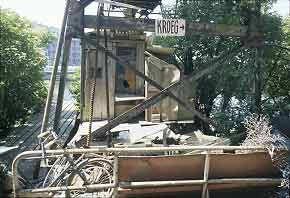
|
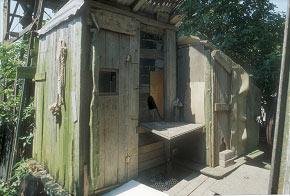
|
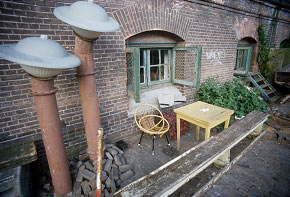
|
|
THE DIJK CHICKEN HUTCH
UNDER THE SLURF
(pic
6-94 / to W)
|
THE DIJK CHICKEN HUTCH
(pic
6-94 / to WWN)
|
A
SITTING PLACE & HUUB'S LAMPS ON THE DIJK NEAR SIMONA APT'S WINDOW-EXIT
(pic
6-94 / to SE)
|
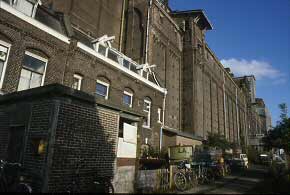
|
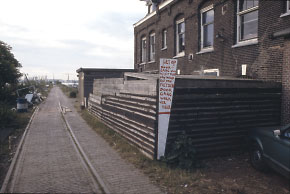
|
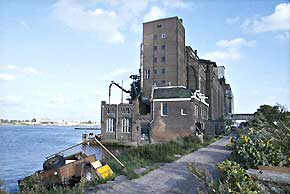
|
|
THE DIJK FACADE FROM NEAR THE NORTH END
(pic 1993 / to SE)
|
THE DIJK PASSES THE NORTH END HOUSE
(pic 6-94 / to N)
|
THE
DIJK PAST THE SILO'S NORTH END
(pic 8-93 / to SE)
Seen
from the dijk the Silo's north end is a jumble of disparate structures.
Built in the 1950s against the Silo's N-wall is the North-Tower, housing a
huge vertical installation for valeting grain. North of that are two
functionally separate buildings: on the quayside is the erstwhile
vacuum-pumping house (now the collective's public cafe-bar, the Kroeg); on
the dijk side is a conventional house built for
essential on-site
staff (now occupied by an independent squatter).
|
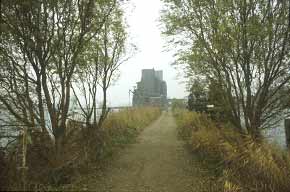
|
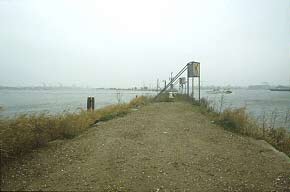
|
|
|
WESTERDOKSDIJK
NORTH OF THE SILO
(pic
11-97 / to SSE)
At
the Silo's northern end its railed and cobbled frontage becomes an earth and
gravel path.
|
WESTERDOKSDIJK
NORTH OF THE SILO
(pic
11-97 / to NNW)
Westerdokdijk's northern
tip.
|
|
.
the QUAY
I have a problem
where to place the Quay in this account. Though an aspect of the Silo and its site as essential as the Dijk, it is such an integral part of the private Silo, so
unaccessable to strangers, that I have decided to show it as a part of the Silo's "PRIVATE
CIRCULATION", which is the main subject of the next page: "the
GROUND FLOOR".
The Quay is the
exterior
component (and in two cases: the otherwise isolated S-Tower and the New-Silo - the only connector) of all the Silos' domestic circulations. It functions as a
second 'gang' joining all the water-fronting entrances and thus every
internal route; its upper portion is sometimes used (especially by those whose apts have
quay-doors) for recreation and small gardens; its lower
portion is a private mooring place for the boats of residents and their visiting
friends.
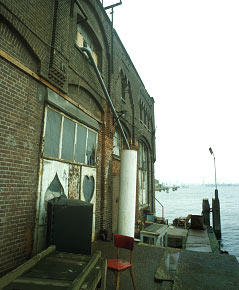
|
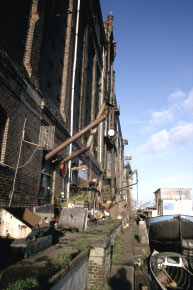
|
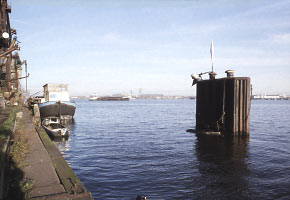
|
|
SILO
QUAY: N-END - THE KROEG'S QUAY
(pic 11-97 / to NNW)
|
SILO QUAY: FROM CHAMBER 5(S)
(pic 11-97 / to NNW)
|
SILO QUAY & DUKDALF FROM
CHAMBER 6(S)
(paste-up
x2 pics
11-97 / to N)
|
.
THE SQUATTING
[ NB: THIS ACCOUNT OF THE SQUATTING AND ESTABLISHMENT OF THE PRESENT CONDITIONS IS
AN AVERAGE OF SURPRISINGLY DIVERGENT MEMORIES - TO ASCERTAIN THE ‘FACTS’ WILL NEED A SIFTING OF THE VERENIGING
ARCHIVE ]
The Silo Company abandoned
the site in 1986, after which the Old Silo was briefly occupied by a few unpaid
company-approved ‘anti-squatters’ (a compliant squatter sub-species installed by building owners to pre-empt invasion by the more politically or
domestically determined). They were
confined to the rooms off the central stair: the offices and lab (the only
location in the building made to serve human needs before those of grain or
machines); they are said to have found the huge bizarre rat-ridden dust-drowned
creaking building “uncomfortable”. Lacking the incentive to exercise that
expressive ‘free-will’ that is the raison-d’être of living in such a
place, they consequently abandoned it (having achieved nothing). About a year later the Silo was squatted.
The two Princengracht sqats:
“Boelgakov” (a late 17thC warehouse, now "yuppie
housing") and “Bührmann” (a factory now destroyed) were threatened
with eviction and small groups from each joined to squat the Silo.On the afternoon of May 28th 1989 a small invasion, planned in
Bührmann that morning, arrived at the Old-Silo in two boats, prized open the
central rear door (and lost their jemmy in 9m of quay water) - 8 to 10 people
entered, some 12 gathered later (memories differ!).
They took the central-stair rooms
- home of the anti-squatters (gas and water worked and the rooms were almost
clean). They organised a rota to
live there and guard - by day there would be six to ten, at night perhaps four
to six on the floor in sleeping-bags, (in the summer there was often only one).
The Company had separated-off their ‘anti-squatter reservation’ from
the adventure of the rest of the building: the stair-top was locked and the
great galleries of the ground-floor closed by flimsy partitions - behind them it
was “very dark and sinister” though one could “walk through and see
all”: a multitude of wooden tubes hung from steel ceiling-pipes, there were
“millions of moths” and thick dust was everywhere, one could “see rats all
over the place, they were not afraid at all” (they peacefully co-existed until
it was cleaned, then left).
That spring they cleaned the
building - a task that (it was said) was inevitably a commitment test! - many
boatloads of dust were ferried to the incinerator opposite the Silo. That summer the energetic and resourceful Mirjam - insisting that the
Silo put itself on Amsterdam’s mental map immediately - organised (with two
male helpers) “Exilo”, an extraordinary event that is still remembered by
many who have never revisited the site. ‘All’
the artists of Amsterdam were invited to use the Silo as a venue for work and
‘all’ the rest of Amsterdam to participate. Groups
of visitors were "led through the building on DADA-like tours".
The whole Silo was open - a vast extension of the art-installations and
performances: building of living-spaces had hardly begun to obscure its volumes
- people unconnected with it still tell experiences that I’m sure are less
memories of architecture than fantasies provoked by the astonishing scale and
exposure to spaces and structures afforded by unrestricted access to catwalks,
the rims of huge pits, towers of pierced stairs, thickets of fragmented
machinery.
The Old Silo was a
resource-mine, especially of metal. As
the building was cleared and its installations dismantled, materials and objects
were released for use and sale: “boats full of metal...[especially unweldable
cast-iron]...were sold to scrap-dealers”; the useful and “beautiful pieces
were kept” [MILOU] - “for a few
years all the ground-floor store-spaces were full of metal” (as well as
machines, ladders, tools, chains, belting, etc.).
Wood was needed immediately
for repair and conversion, and increasingly for apartment building and heating. Much was fished from the water; local housing demolitions provided
structural timbers, planks, doors and windows; terminal squats (Boelgakov and Bührmann
especially, before the summer ‘90 evictions) were stripped of useful,
memorable and beautiful things.
“First conquer the
place!” [DIDERIK] ... from mid ‘89 through 1990/91 the Silo slowly
trans-formed from work-camp to a working ‘village’. Through summer '89 until
november (spurred by the Electric Company's ultimatum) Marcel
organised the huge task of tracing and rewiring
all the Silo's circuits with
scavenged cable
(for this achievement he
was accepted by the Collective).
In autumn '89 they planned the building's divisions and “walked round
choosing spaces”, and began converting the vacuum-pumping house at the north
water-corner into a public restaurant-bar (the “Kroeg” - opened in 1990).
By
summer '90 Marcel had domesticated the bizarre South Drying Tower.
In spring ‘90 the arrival of
Brian “brought a new kind of energy into the place” [MILOU].
A prime-mover in the domestication of the forbidding “Iron-Tower” (the North
Drying Tower) -
with Mark its first occupier he cleared the bulk of its huge metal
installations, a feat of ruthless resourcefulness and sustained work that by
summer ‘91 enabled five habitable levels.
By the end of 1990 about
half the Silo’s potential living-spaces were claimed (though many working
there still lived outside). Each of
its distinct environments had attracted its ‘appropriate’ inhabitants - in
the open attics, the massively bulwarked cavities of the ground-floor, both
machine-filled drying-towers, even in the small ‘gothic’ “Round-Tower”,
apt building was in progress.
The Silo squat was already
registered with the City as a legal entity: the ‘Vereniging tot behoud van de
Graan-Silo’ (“Collective to preserve the Grain-Silo”), with Chairperson,
Secretary, Treasurer, and an office. Many applied to join the now famous enterprise, wanting living- or working-spaces -
finding they must build their own some went away - of those accepted some failed
to realise their conception or prevaricated (sometimes for months before being
told to move-in or go). Everyone who joined paid 100 guilders per month into a common fund for bills, repairs,
materials.
By the end of ‘91 this
extraordinary co-operative enterprise was securely established - though still in
an early stage of ‘communal’ energy, still needing or retaining the habits
of a collective. Much more than now [1996] the place was socially and physically open, less closed by substantial apartment
walls and immersion in private aims; there was more participation in the
Silo’s ethos and events, people would take pleasure in sharing work, simple
tasks like foraging in the streets for firewood were social occasions.
The Silo was
increasingly opening to public participation. By
december
'93 Marcel
had made his most
radical contribution to the
collective's domain
by enabling the neighbouring New-Silo for regular public use - for internally
and externally organised art and 'rave' events. In '9#
the "Silo Galerie" [for internal and external art shows] was opened in
the vertical-conveyor room under the 'Slurf' and in '9#
Milou et al established the "Silo-Theatre". By '9#
the Silo's participation was a substantial portion of Amsterdam's annual
festival "Parade".
Today [1996] the Silo is home for
40 people and work-space for a few who live outside. All types of skills are represented - only a quarter are artists,
performers, designers. There are 33 private spaces from small to huge - most are
elaborate apartments that often include workshop/studio-space (which tends to
diminish as domestic functions evolve); in at least 2 the workshop almost
completely eclipses domestic provisions; only 3 are pure studios. The Old Silo
is comprehensively but not fully occupied: the community has stabilised at a
number of individuals too few to need to utilise all easily habitable spaces
(let alone the daunting possibility of converting the windowless
silo-cavities!). There are still
large spaces used only as stores; the upper halves of the ground-floor’s high
access/workshop/store chambers could accommodate small apts (a ‘small-scale
model’ is Simona’s living-room in Duro Toomato’s store-space); and under
extreme population-pressure certain very large apts/workshops could divide and
differentiate (a process ‘sketched’ in Milou Veling’s internal
‘guest-house’). The results of
a population expansion such as followed Tetterode’s legalisation are far less
predictable in the topographically awkward Silo - it would effect a
‘transformation’ rather than Tetterode’s simple multiplication of
divisions. At present [1996] many apts are still evolving and there are
unresolved Collective projects (such as the use of the New-Silo).
The largest uncertainty concerns the future of the whole site: an ongoing
discussion with various City institutions [1].
Foot-Note :
-
Alas - the Silo was finally emptied in early 1998; nothing improvised was saved:
its surrounding site and the interiors of the
two Silos are now (2005)
completely destroyed [Re: APPENDIX 3].
.
THE FORM OF THE BUILDING
S
The site began in 1907 with the building
of Jacob Klinkhamer’s 1892 designed “Old Silo” and was extended in the 1950’s with a massive concrete “New Silo”.
The Old Silo’s brick and wood
structure is inherently complex and has accumulated internal modifications and
external additions, whereas the New Silo’s reinforced-concrete and steel
spaces are simple and vast - however apart from such historical differences the
two buildings are similar in essentials of operation and form. The Old Silo however is as if ‘doubled’: as if two equal and opposite
Silos are face to face sharing at the centre the facilities associated with the
New Silo’s tower: vertical conveyors and access stairs (and the whole site's
admin offices).
Since I’m more concerned with
the results of the occupation than the original use of the buildings, the
account below concentrates on the completely inhabited Old Silo rather than the
sparsely used New Silo (briefly described in relation to its rave-venue basement
and single apt).
In spite of his obsession with
building for industry (“Industrial buildings are the new sacred buildings”)
Klinkhamer, like most 19thC architects, is lost in the pictorial and ignores
the drama of the actual (industrial) activity.
Except for a sense of some large-scale internal physical action conveyed
by the towering blankness of its facades and the flowering emergence on them of
1300-plus steel reinforcing-rod rosettes - he disguises his Silo’s intensely
active mechanism-dominated interior behind a tableau of ‘Chateau-Gothique’
and takes no design-responsibility for installations (pneumatic elevators, etc.)
that deface and penetrate its walls.
Of all the actions associated with
valeting grains, that of storage dominates the building’s form.
In each of its wings, between their attics and their ground floor, is an
18m-deep volume of silos - two vast ‘crates’ of (in total) 120 brick cells
criss-crossed by reinforcing rods (to prevent the thin walls of the filled ones
bulging and bursting). All around
the vertical perimeters of these central blocks of storage-cavities were the
devices and machines that served them and the grain: the motors and pumps,
hoppers and bins, sievers, dryers, cyclone-cleaners, weighers, baggers, and of
course transporters: horizontal band-conveyors, vertical bucket-conveyors, and
in every direction, pipes (“chutes”) and ducts.
To empty and fill the ships and
barges suction derricks (“pneumatic ship-unloaders”) projected from the
water-front facade (one still droops its hose next to the Kroeg) or floated
independently, serving large ships moored outside the duckdalfs.
Grain sucked from ships was poured through feed-hoppers to conveyors
running beneath the quay - routed to the New Silo; to the stacked dryers and
cleaners in the Old Silo’s end towers, or bucket-elevated up its centre into
the surmounting pyramid and poured through its ‘distributor’ onto the
conveyors of the great central loft, driven out into the attics of the wings to
fill from above the ranks of silos, to be later discharged 18m beneath onto the
conveyors in the caverns of the ground-floor.
The
Silo is formed differently from the other three buildings in this book -
Tetterode, De Loods, Edelweis were built to house rather than embody the
purposes they serve. Though industrial - Tetterode's grouped buildings enclose
conventional stacks of floors: workshops for machine-assisted production - the
whole place is primarily a human environment. The Silo - doing nothing so
complicated as manufacture: simply serving a raw-material - is an object
half-way between say 'crane' and 'factory': it is almost as if just one of the
machines on Tetterode's workshop floors had expanded into a building which contains
its human operators as working-parts.
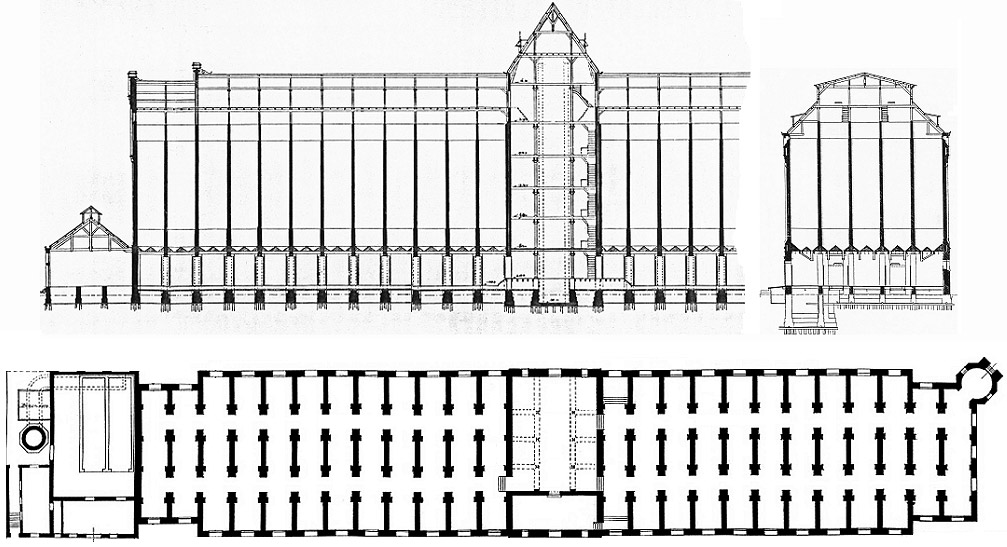 |
|
SILO
- LONG SECTION [to EEN] / CROSS SECTION [to SSE] /
PLAN GROUND-FLOOR [top EEN]
(original-drawings: Klinkhamer, et al - 11-1896) [annotated
ver]
|
|
ext-toNNE.jpg)
|
ext-Snd+bots.jpg)
|
KRO+pmp.jpg)
|
|
SILO
PRE-SQUAT: BETWEEN 1900 & 1910
(pic between 1900 & 1910 / to NNE) - (pic: Municipal Archives
Amsterdam)
The main building, designed by Jacob Klinkhamer
in 1896, demonstrates typical 19thC disjunction of
'architecturally-styled' parts & 'merely-functional' parts!. The small cubic addition at the near
end (south) was probably added
between 1900 & 1910; in the 1940s(?) it was crudely heightened to
house a vertical grain dryer-stack.
|
SILO
PRE-SQUAT: N END DOCK & QUAY IN 1930's
(pic:
1930's / to N) - (pic: Municipal Archives Amsterdam)
The
space where the 1950's New Silo would be built (possibly mistakenly
positioned !) was then apparantly a dock for barges. There is a bucket-elevator
mounted (incongrously) on the 'gothique' Corner-Tower. Huge 'pneumatic
ship-unloaders' - scaled to the biggest ships - float outside the
'dukdalfs'.
|
SILO
PRE-SQUAT: VACUUM-PUMP IN THE PRESENT KROEG SITE
(pic:
10-1987 / to SE) - (pic: Municipal Archives Amsterdam)
In
the space that is now the "Kroeg" this huge machine made vacuum for the suction
derricks of the quay. Its big (about 4.5m) flywheel spun between two pumps
mounted on brick plinths.
When the Silo was squatted it had
already been removed by the building's owners.
|
|
GNG+band.jpg)
|
MUS-distr-W.jpg)
|
MUS-band.jpg)
|
|
SILO
PRE-SQUAT: GROUND-FLOOR GRAIN-CONVEYORS
(pic:
10-1987 / to S ) - (pic: Municipal Archives
Amsterdam)
This
is now the north Gang, viewed towards the south from
'chamber-8'. The grain conveyors were then in open troughs and though the
massive silo-supporting walls encumbered the volume of the huge sunken
hall no apt-walls cut portions from its continuity.
The
overhead silos discharged through valved metal pipes whose flow was
directed to the conveyor by movable wooden chutes.
|
SILO
PRE-SQUAT: CENTRE-ATTIC GRAIN 'DISTRIBUTOR'
(pic:
10-1987 / to W) - (pic: Municipal Archives Amsterdam)
This
huge central attic is named the "Museum" for displaying the grotesque
remains of installations such as this central feature - a 'distributor'.
This structure of chutes directed grain from the "Pyramid" loft above onto 4 conveyors that
transported it through the North and South Attics.
|
SILO
PRE-SQUAT: CENTRE-ATTIC GRAIN CONVEYORS
(pic:
10-1987 / to SW) - (pic: Municipal Archives Amsterdam)
Here
one of the two South-Attic conveyors rises from the 'distributor' and passes into the
1.8m raised Attic through an entry port in the "Museum's" south
wall . |
ATT+band+sil.jpg)
|
|
|
|
SILO
PRE-SQUAT: ATTIC GRAIN-CONVEYORS
(pic:
10-1987 / to N/S(?) ) - (pic: Municipal Archives Amsterdam)
The
Attics of the north and south wings are the silos' 'charging-floors'.
Here the
conveyors that emerged from the
"Museum" discharged their grain
into the tops of the 120 silos. Conveyors
were looped through rail-travelling 'throw-off carrages'
[pic cntr] that diverted their grain into the flanking silo openings.
|
|
|
.
THE SHAPE OF
THE OCCUPATION
Only round the edges of the un-inhabitable silo cavities, in the spaces once used by the machines that
served them, and in the admin offices of the central stair, was occupation
possible - only these spaces had provisions for humans: stairs, floors and
windows, and could be made habitable or at least suitable for apartment building
without major structural additions. Except
for twinned apts in the spacious offices, the narrowness of the building and the
needs of access precluded more than a single line of living-spaces. Thus the curious form of the occupation is emphasised - like
an ant-burrow exhibited between planes of glass, constrained to grow as a
two-dimensional shape - tracing the vertical edges of the building’s two
rectangular wings: passing up the stair between them, travelling across their
tops in the low wooden attics, bracketing their ends inside the bizarre drying
towers, and infesting their dark and massive ground-floors. A vertical linear-village of environmentally distinct
mini-regions, whose simple overall shape is most easily apprehended from
outside. Touring the interior
it’s difficult to remember the building’s symmetry and repetitiveness -
distracted by the ad hoc opportunism and individualism of the occupation and
surprised by intrusive fragments of machine-installations as senseless as
semi-buried ruins.
AN ENVIRONMENT OF PSYCHO-PHYSICAL AFFECTS
DANGER, SPACE, VITALITY
The Silo is a zone of traps - minor and major hazards from a bruise to death - a
bruised head from a low steel lintel to tripping on a proud board and plunging
20 metres through a gap in the room’s floor! The threat of danger - at least before complete familiarity with the
terrain (which however is always changing in at least small ways) - makes one
attend to ones body, its movements and surroundings, adding a dimension of
awareness unusual in habitual living - a state of enhanced sensations and
vitality of being.
There are indications that some at least enjoy the hazards - retaining
open deadly ducts and holes, unprotected hoist-shafts, absent portions of floor,
spidery and insecure ladders; as well as building in bizarre locations:
platforms intruding over the voids of silos, colonising towers; socialising the
roofs like cats, scaling the walls - there have been accidents and falls, none
fatal !
HOME,
JUXTAPOSITIONS, DREAMS
The
acute foreground of danger tends to obscure a more subtle and pervasive sense of
spatial fallibilities in this huge machine-building - disquietingly evocative of
the fragility of domestic life and individuality!
For example:
In
the great wooden lofts under the marvellous roof, where deep-beamed galleon-like
apartments span the width in a relaxing amplitude, one never quite loses a sense
of ‘suspension near the sky’ as if the whole floor is airship-hung, a
hovering plane.
The solidity and comfort of these homes, the massive assurance of their
steel-strapped beams and concrete floors cannot quite dispel a sense of magic -
as if they are held out over nothing like a gift or dream.
Across
their floors orderly lines of pierced steel floor-plates (stuffed with
draught-excluding foam or sealed with tape) can thinly open into the deep brick
cavities of silos - seen with domestic eyes seemingly monstrous constructions
made for nothing but emptiness (unless one has unluckily inherited the few with
rotting grain).They are not analogues of ‘drains’ or ‘under-floor cavities’:
those are extensions of the sink and house - these cavities are nothing at all
to do with the houses built on the top of their ’charging-floor’ (where huge
band-conveyors ran feeding these holes) - a palpable physical, functional,
historical gap separates them; but visually and mentally they conjoin: thus the
psyche is thrown into ‘shock’ - used to coherent objects it gropes for a
reason commensurate with the vision, and finding none begins to ‘dream’!
The proximity of these bizarre, irrational, primitive gulfs concealed
beneath the surface layer of dwellings and waking needs of living, inevitably
provokes ‘symbolic perception’: a sense of the insecurity of the thin skin
of consciousness over the great dark beneath (the two places that are merged in
the lost places of Piranesi’s ‘Prisons’).
In
the apartments and spaces of the lowest level beneath the silos one may become
aware of a contrasting sensation: an oppression from above (or at least the
preparations to resist it) - a continual effort of support expressed by the
thick-walled caverns of grain-supporting masonry.
The overbearing silos (18 meter hollows up to the floors of the
sky-touching lofts) protrude through the close-girdered ceilings as rows of
scarlet discharge-tubes: one dribbles a tar with a smell of breweries evaporated
to an unquenchable pungency; others spill a thin stream of grain and scurrying
beetles, or spurt water when rain falls through the outer silos from the broken
tiles of the lateral roofs.
Attempts to seal the flows are often overwhelmed: yellow fungi of
polystyrene foam bulge from the tube-mouths, suspended buckets discretely cup
yawning tube-ends, or collecting bags are held bound around the throats of tubes
with tourniquets of tape and wire, determined to suspend the weight of disgorge.
All reinforce the feeling of living under a hollow albeit active entity.
The
ubiquitous spatial disquiet is brought to a sharp focus in the drying towers at
the Silo’s ends, where the dichotomy of ’cosy-homes’ and harsh industrial
structures is at its most acute.
Secure within a habitation one may forget that beyond its threshold is a
dizzy climb where up and down both conveyed the threat of falling among a
multitude of views through the thin girders and pierced-steel stairs.
In
3½ months residency I was not habituated to this environment which continued to
demand attention, and consequent exhaustion. Lack of rest not only for the body watching for dangers, but also the
mind working to make sense of context-lesions and besieged by ‘first-time
objects’: the experiential hyper-activity of inventions and wit.
‘FIRST-TIME
OBJECTS’ - PHYSICAL AND PSYCHIC PRESENTNESS
[‘...is there no escape from Numbers and Beings!’ - Baudelaire, Les Fleurs du
Mal, “The Pit” 1862.]
‘First-time
objects’ are the norm in the Silo. Things are made (and found) in a very immediate way that conveys the
present-moment of the act. Continual confrontation with such active objects is
exhausting. Such objects behave their being, their making, and their use -
actively and continually signalling these.
There
is nothing especially ‘original’ about the majority of Silo objects and
arrangements except this ‘present-momentness’ - a characteristic of things
made in a ‘real-time’ state of attention/action, as economically as present
means allowed.
With no style, skill, or finish excessive to the need, not only is their behavior
freed: falling in their curve of gravity, warping with the visible
grain, showing the impact of the hammer; but untrussed by taste and tidiness
their forms are more complex unpredictable and various, more efficient projection-screens for
potential fantasies.
Thus the Silo is physically and psychically eventful.




























ext-toNNE.jpg)
ext-Snd+bots.jpg)
KRO+pmp.jpg)
GNG+band.jpg)
MUS-distr-W.jpg)
MUS-band.jpg)
ATT+band+sil.jpg)
